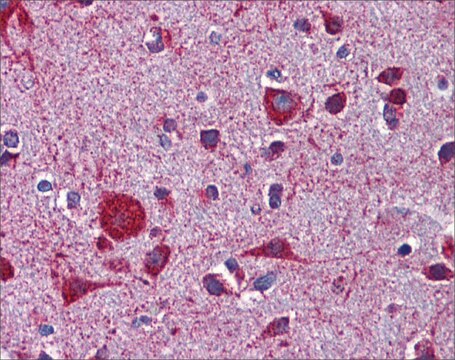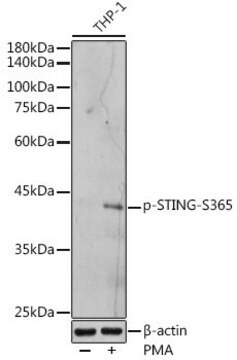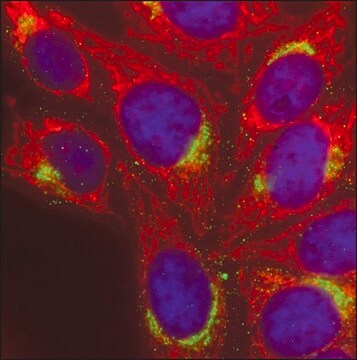一般說明
We are committed to bringing you greener alternative products, which adhere to one or more of The 12 Principles of Green Chemistry.This antibody is Preservative-free, produced without the harm or sacrifice of animals and exceptionally stable to allow for ambient shipping and storage if needed and thus aligns with "Waste Prevention", "Designing Safer Chemicals" and "Design for Energy Efficiency".
Click here for more information.
ZooMAb® antibodies represent an entirely new generation of recombinant monoclonal antibodies.Each ZooMAb® antibody is manufactured using our proprietary recombinant expression system, purified to homogeneity, and precisely dispensed to produce robust and highly reproducible lot-to-lot consistency. Only top-performing clones are released for use by researchers. Each antibody is validated for high specificity and affinity across multiple applications, including its most commonly used application. ZooMAb® antibodies are reliably available and ready to ship when you need them.
特異性
Clone 1C19 is a ZooMAb® Rabbit recombinant monoclonal antibody that specifically detects Human CD5. It targets an epitope within 19 amino acids from the N-terminal, extracellular domain.
免疫原
KLH-conjugated linear peptide corresponding to 19 amino acids from the N-terminal, extracellular domain of human CD5.
應用
Quality Control Testing
Evaluated by Western Blotting in Jurkat cell lysate.
Western Blotting Analysis: A 1:1,000 dilution of this antibody detected CD5 in Jurkat cell lysate.
Tested applications
Immunohistochemistry (Paraffin) Analysis: A 1:1,000 dilution from a representative lot detected CD5 in human tonsil tissue sections.
Immunocytochemistry Analysis: A 1:100 dilution from a representative lot detected CD5 in Jurkat cells..
Affinity Binding Assay: A representative lot of this antibody bound CD5 peptide with a KD of 1.0 x 10-12 in an affinity binding assay.
Note: Actual optimal working dilutions must be determined by end user as specimens, and experimental conditions may vary with the end user
標靶描述
T-cell surface glycoprotein CD5 (UniProt: P06127; also known as Lymphocyte antigen T1/Leu-1, CD5) is encoded by the CD5 (also known as LEU1) gene (Gene ID: 921) in human. CD5 is a single-pass type I membrane protein that is synthesized with a signal peptide (aa 1-24), which is subsequently cleaved off to produce the mature form that contains an extracellular domain (aa 25-372), a transmembrane domain (aa 373-402), and a cytoplasmic domain (aa 403-495). The extracellular region contains three scavenger receptor cysteine rich (SRCR) domains. CD5 is expressed on the surface of all T cells bearing the β heterodimer T cell receptor (TCR) but is absent or present at lower density on the T cell subset. It is involved in the regulation of T cell function and proliferation. It is also detected on a subset of B cells, specifically the B1 cells. However, B cells usually express two-to-five-fold fewer CD5 molecules per cell than T cells. In B cells, CD5 promotes constitutive activation of pERK1/2 in a calcium-dependent manner and involves the non-selective TRPC1 channel. In the C-terminal region, CD5 contains four tyrosine residues that can be phosphorylated by Lyn kinase to create binding sies for SHP-1 (PTPN6). CD5 is shown to be constitutively associated with SHP-1 and their interaction increases upon TCR stimulation. In mature, peripheral T cells, CD5 is present in lipid rafts of the T cell surface, where it promotes CD3 redistribution into rafts, which upregulates the activation of ZAP-70, linker for activation of T cells (LAT), and Ca2+ influx. This ZooMAb® recombinant monoclonal antibody, generated by our propriety technology, offers significantly enhanced specificity, affinity, reproducibility, and stability over conventional monoclonals. (Ref.: Voisinne, G., et al. (2018). Front. Immunol. 9; 2900; Garaud, S., et al. (2018). Cell. Mol. Immunol. 15(2); 158-170).
外觀
Purified recombinant rabbit monoclonal antibody IgG, lyophilized in PBS, 5% Trehalose, normal appearance a coarse or translucent resin. The PBS/trehalose components in the ZooMAb formulation can have the appearance of a semi-solid (bead like gel) after lyophilization. This is a normal phenomenon. Please follow the recommended reconstitution procedure in the data sheet to dissolve the semi-solid, bead-like, gel-appearing material. The resulting antibody solution is completely stable and functional as proven by full functional testing. Contains no biocide or preservatives, such as azide, or any animal by-products. Larger pack sizes provided as multiples of 25 μL.
重構
300 μg/mL after reconstitution at 25 μL per vial. Please refer to guidance on suggested starting dilutions and/or titers per application and sample type.
儲存和穩定性
Recommend storage of lyophilized product at 2-8°C; Before reconstitution, micro-centrifuge vials briefly to spin down material to bottom of the vial; Reconstitute each vial by adding 25 μL of filtered lab grade water or PBS; Reconstituted antibodies can be stored at 2-8°C, or -20°C for long term storage. Avoid repeated freeze-thaws.
法律資訊
ZooMAb is a registered trademark of Merck KGaA, Darmstadt, Germany
免責聲明
Unless otherwise stated in our catalog or other company documentation accompanying the product(s), our products are intended for research use only and are not to be used for any other purpose, which includes but is not limited to, unauthorized commercial uses, in vitro diagnostic uses, ex vivo or in vivo therapeutic uses or any type of consumption or application to humans or animals.










